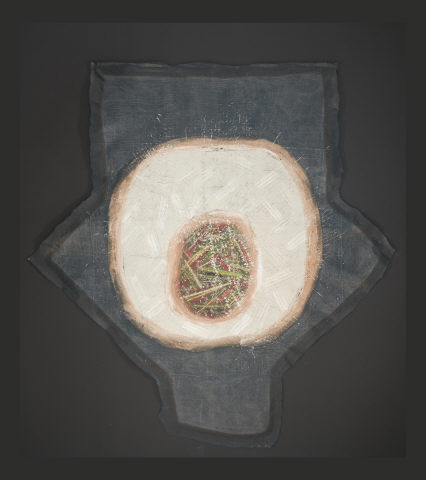
- 1981
- Carton
- Acrylic paint, Graphite, Assemblage and Pastel
- Inv. PE48
Maya Andersson
Usumacinta (Vallée)
Artist's statement:
In the eighties I used to undertake a very “physical” work, in the sense that my body was intensely involved in the creation of each painting. I would tear fragments of asphalted paper apart and bring them together, starting by one of the pieces until I could obtain a convenient form, in keeping with its irregular outline. After this assemblage, the paper was then glued over the canvas. I would kneel down on the ground right in the middle of the surface. With my hands full of the region's sand, dry and sifted, mixed with acrylic resine, I would trace a first circle as close as possible to my legs to delineate a sort of very condensed core. Then, spreading my arms as far as I could, another circle was sketched, much wider, in order to circumscribe a broader workplace. Afterwards, I walked over these traces in order to scatter the sandpaths, that were duplicated on the inside with white pigment and on the outside with black pigment. Each zone between these “paths” was then reworked according to a specific purpose:
– the centre as a space of maximum concentration, an organized chaos, profound and intense.
– the intermediate space as a relational, dynamic, expressive and luminous core, where splatters would fall over in both inner and outer zones.
– the external space as a limited infinite, self-contained in a light architectonic form; painted in black and then retouched with charcoal so as to obtain a certain brilliance that was able to emphasize the accidents of the medium
The paths/limits of the surface were then sanded so as to uncover the asphalt contained in the paper. This was an additional way to wear out the limit between painting, as a populated space, and the nothingness that surrounds it. Each of the three “paths” was regarded as a line, and its porose, permeable and epidermic matter, made way for the circulation of a necessary energy in this work.
I sought my inspirations in the sacred architecture of different cultures: Christian, Byzantine and Islamic (plans of several religious buildings), temples and pyramids from pre-Columbian (Tikal, Chichén Itzá), Asian (Borobudur), or Egyptian civilizations (the sequence of rooms, the dimensions and the different functions), where buildings were determined by a certain amount of rules that dictated the location, dimension and orientation of the elements. These building plans have nurtured my imagery and, by extension, the “landscapes” in which they were built.
My work on the floor and the large format of the surface were equivalent to territories that could be walked in, or “cultivated” as if it was a land. The tools I used were rather similar to gardening tools: my hands, my nails, a sandpaper, sand, and instead of brushes, tally sticks, scrapers and rakes.
I resumed the “painting” the moment it was hanged, because it revealed an orientation, the four cardinal points towards which forms are drawn.*
Usumacinta is the name of a river in southern Mexico that runs 560 kilometers long. The nascent is in Guatemala, it serves as a frontier to the Mexican state of Chiapas and crosses through the tropical forests of Tabasco and Campeche before flowing into the gulf of Mexico. I have never visited it, but in November 1991, when working in a cold and unconfortable studio in the southeast of France, I was momentarily in need of dreaming with tropical forests, humid and warm valleys in the ways of Mayan people… this was probably the reason why I gave the painting this title!
Maya Andersson
Bouliac, February 18th, 2010
* Cf. Exhibition catalogue Images de la Suisse française, pays de Vaud. Huit peintres, huit cinéastes (1982), text by Claude Ritschard.
| Type | Value | Unit | Section |
| Width | 290 | cm | |
| Height | 305 | cm |
| Type | signature |
| Text | Maya Andersson |
| Position | back |
| Type | date |
| Text | 11/1981 |
| Position | back |
| Type | Acquisition |
| Date | June 1982 |
| Imagens da Suíça francesa - Cantão de Vaud - oito pintores/oito cineastas |
| Calouste Gulbenkian Foundation |
| 3 June to July 1982 |
| Inauguração do CAM |
| CAM/FCG |
| 20 July 1983 Lisbon, CAM/FCG |